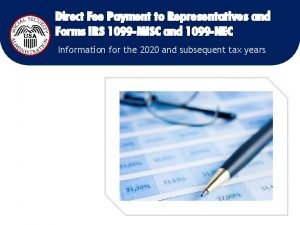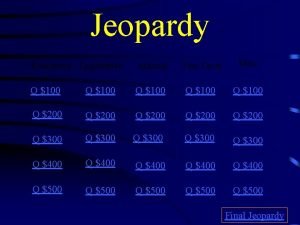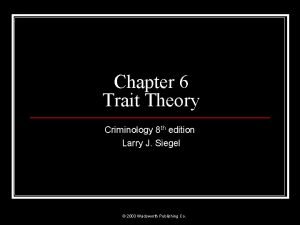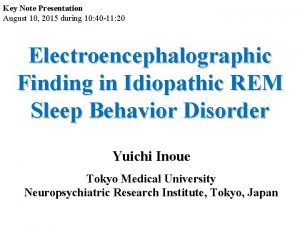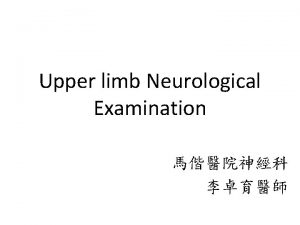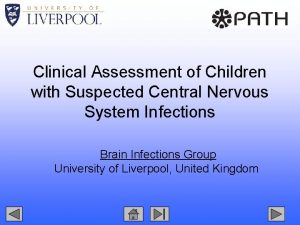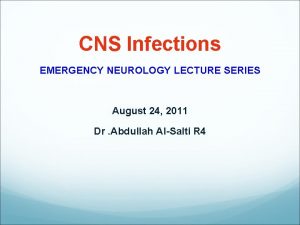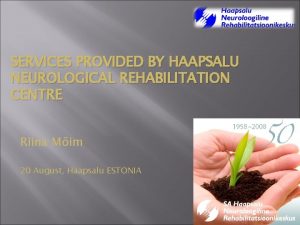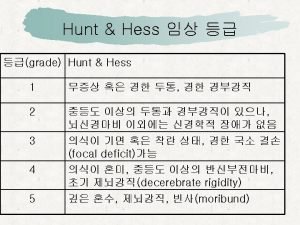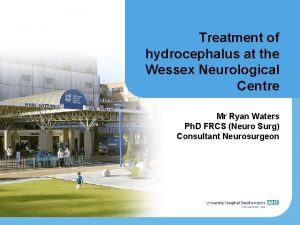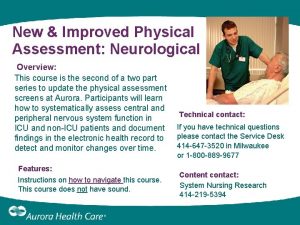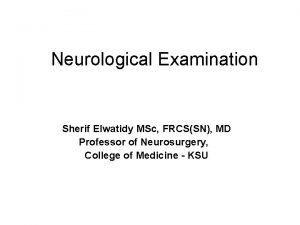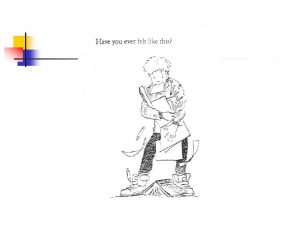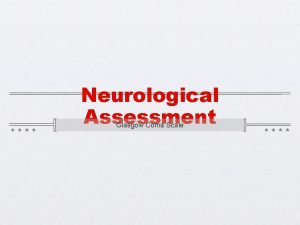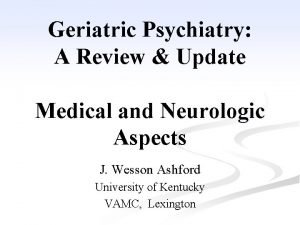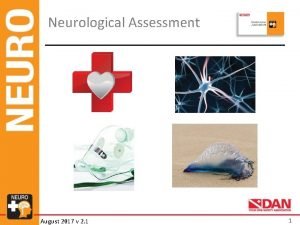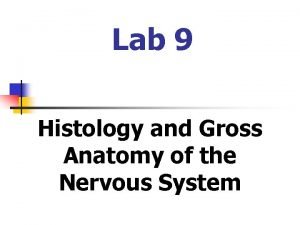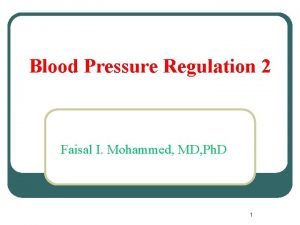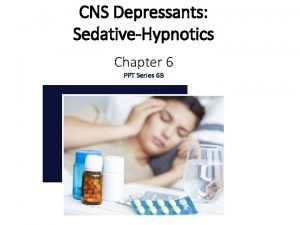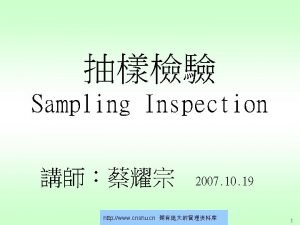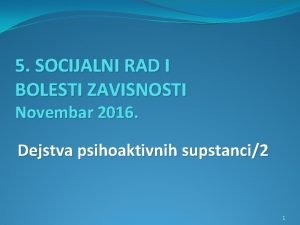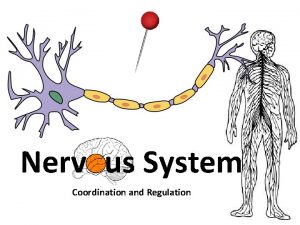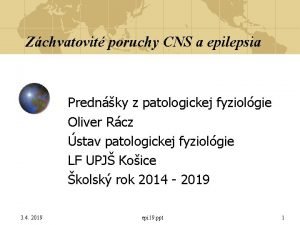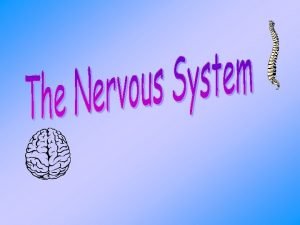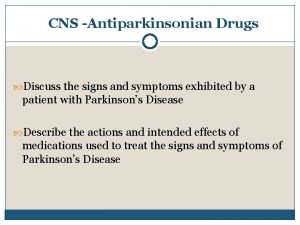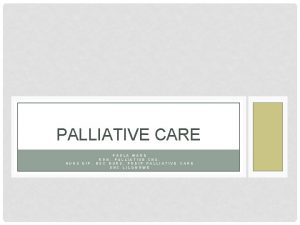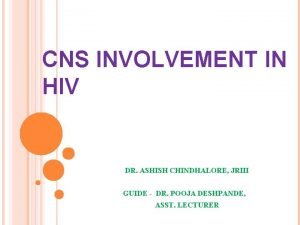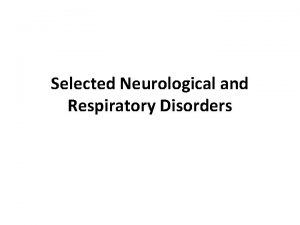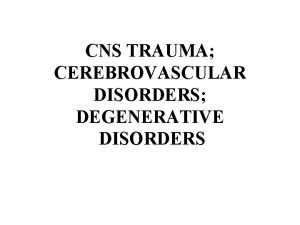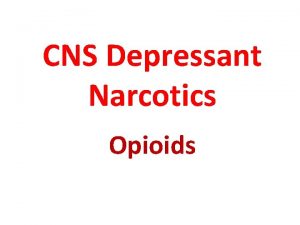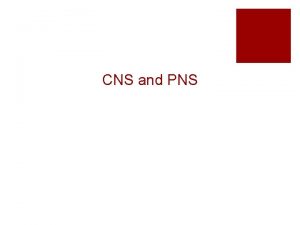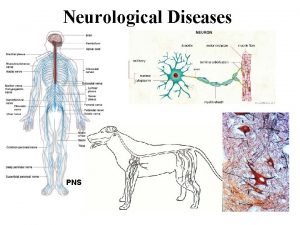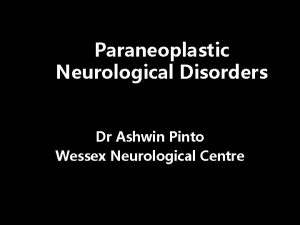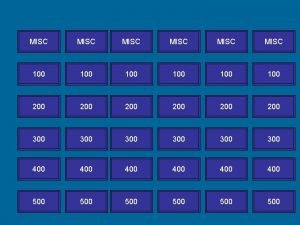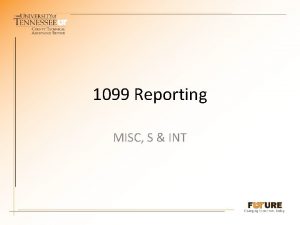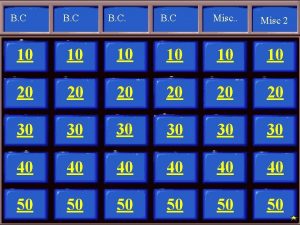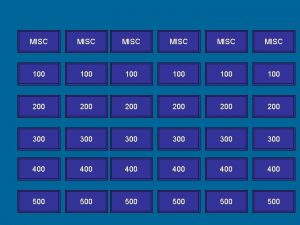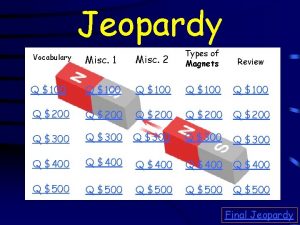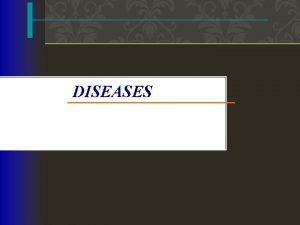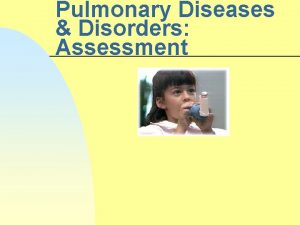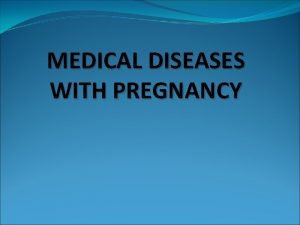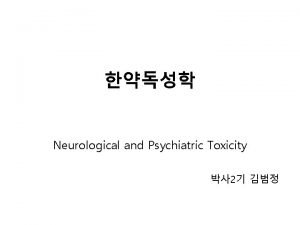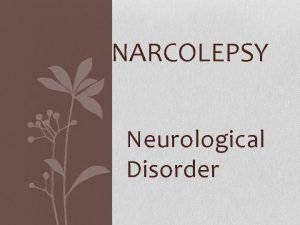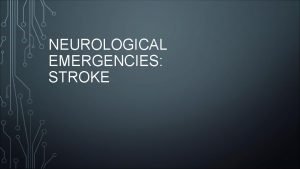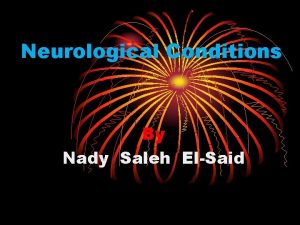CNS Disorders Misc Neurological Disorders Week 8 Diseases


















































- Slides: 50

CNS Disorders & Misc Neurological Disorders Week 8


Diseases du jour • • • Parkinson's Alzheimer's Epilepsy Muscle Spasm Brain Trauma Meningitis, Encephalitis • CVA • Peripheral – Multiple Sclerosis – Guillain-Barre Syndrome – Amyotrophic Lateral Sclerosis

CNS Pharmacology • Peripheral neurotransmitters = 3 • CNS neurotransmitters = at least 12 – Exact actions may be unknown – Areas of brain with no known transmitter • Blood-brain barrier • Pharmacologic considerations – Delayed full effect – Tolerance, decreased side effects – Physical dependence

Parkinson's Disease • Extrapyramidal system – Neuronal network responsible for regulation of movement – Dyskinesias • Tremor, Mask • Postural instability • Bradykinesia, akathisia – Psychologic disturbance • Dementia, depression, impaired memory

Parkinson's Disease • Balance Neurotransmitters in EPS striatum – Acetylcholine (excitatory) – Dopamine (inhibitory) • Supplied by neurons in substantia nigra • 70 -80% of dopamine supplying neurons must be lost before Parkinson's symptoms appear

Parkinson's Treatment • Currently unable to reverse degeneration • Drugs improve dyskinesias, but not tremor and rigidity • Drug Strategies – Increase dopamine (Dopaminergic) – Inhibit acetylcholine (Anticholinergic)

Dopaminergic Drugs • • • Promote dopamine synthesis Stimulate dopamine receptors Inhibit dopamine breakdown Promote dopamine release Block dopamine reuptake Anticholinergics: all block muscarinic receptors

Drug Selection • Mainstay – Levodopa: most effective, long term side effects – Dopamine agonists: less effective, fewer side effects – Combination

Levodopa • Promotes dopamine synthesis in surviving neurons • Highly effective, but fades over time (5 years) • Adverse effects: long term dyskinesias • Acute loss of effect – Gradual “Wearing off” – Abrupt “on-off”

Levodopa • Kinetics – Well absorbed PO, delayed by food, esp protein – Most levodopa metabolized in periphery – Small amount crosses BBB • Adverse effects (most dose dependent) – NV (take on empty stomach) – Dyskinesias (80%) – CV: postural hypotension – Psychosis (20%), neurotoxicity

Levodopa • Drug holiday • Drug Interactions – Conventional antipsychotics – MAO inhibitors – Anticholinergic Drugs • Food Interactions

Levodopa plus Carbidopa • Brand: Sinemet • Most effective PD drug we have • Carbidopa enhances levodopa action – Inhibits peripheral metabolism – Reduces NV, CV effects

Dopamine Agonists • Four drugs – 2 ergot derivatives (bromocriptine and pergolide) – 2 nonergot (pramipexole and ropinirole) • Ergots have more side effects – Nonselective – Also stimulare alpha and serotonin receptors • Nonergot adverse effects: – Nausea, dizziness, day somnolence, insomnia, constipation, hallucinations

Other Parkinson's Drugs • COMT inhibitors • Selegine (MAO-B inhibitor) • Amantidine – Anti-viral – Promotes release of dopamine – May block reuptake • Anticholinergics: reduce tremor, not bradykinesia – Better tolerated, less effective

Alzheimer's Disease • Progressive memory loss and decreased cognitive function • Pathophysiology – Neuronal degeneration – Reduced Cholinergic Transmission • Characteristic morphology – Amyloid plaques – Neurofibrillary tangles – Apo E 4, ER-assoc binding protein, homocysteine

Risk Factors • Age – 90% older than 65 – Rises exponentially thereafter • Early Symptoms – Memory Loss!!! – Disorientation – Changes in personality and judgment

Symptoms Cont • Moderate symptoms – Difficulty with ADLs – Anxiety, suspiciousness, lack of recognition – Sleep disturbance – Wandering, pacing • Severe symptoms – Loss of speech – Loss of appetite – Loss of bladder and bowel control

Evaluation and Treatment • Diagnosis: exclusion • Treatment – Typically die 4 -8 years after diagnosis – Delay progression of symptoms long enough for them to die of something else. – The cardiologists are winning – Drug therapy • Cholinesterase inhibitors • Calcium channel stabilizer

Cholinesterase inhibitor • In Alzheimer's, acetylcholine transmission in brain is 90% lower than with normal aging • Acetylcholine essential forming memories • Inhibitors help ~30% mild-moderate patients • Three agents – Donezepil (Aricept) – Rivastigmine (Exelon) – Galantamine (Razadyne)

Calcium Channel Stabilizer • Amyloid plaques may cause excess influx of calcium into neurons • Memantine (only CCS) – Downregulates calcium channel – “filters out the noise” – Moderate to severe dementia

Epilepsy • Group of related disorders – Excessive neuron excitability in CNS – Seizure • Unconsciousness • Mild Twitching • Convulsions • 100, 000 new cases/year – most in elderly • 300, 000 peds cases in U. S.

Seizures • Focus: group of hyperexcitable neurons – Causes • • Congenital defects Hypoxia at birth Head Trauma Cancer • Seizure – Synchronous, high frequency depolarization of a focus that spreads to other parts of the brain – Manifestations depend on location of focus

Seizure Types • Partial: only part of the brain – Simple – Complex • Generalized: throughout brain – Tonic-clonic (Grand mal) – Absence (Petit mal) – Atonic (head drop, drop attack) – Myoclonic – Status Epilepticus – Febrile: not associated with epilepsy

Seizures • Stages – Aura – Seizure – Post-ictal • • Confusion Disorientation Weakness Hypoglycemia • Status Epilepticus – Seizure that lasts >30 minutes

Anti-Epileptic Drugs • Suppress discharge of neurons in a focus • Suppress propagation of of seizure • Three basic mechanisms – Suppression of Sodium influx – Suppression of Calcium influx – Potentiation of GABA • Therapeutic Goal – Reduce seizures to extent that patients live a normal life; 60 – 70% controlled on therapy – Seizure control vs. tolerability of side effects

Therapy • Non-drug therapy – Surgery – Vagal nerve stimulation – Ketogenic diet • Drug selection – Drug must be matched to seizure type – Evaluation • Hx: Symptoms and precipitating events • Neurologic examination • EEG, CT, PET, MRI

Drug Therapy • Acute Seizure: benzo (diazepam, lorazepam) • Trial Period – establish effectiveness – No driving, operating heavy machinery, swimming must be supervised, etc. – May need to switch agents or add a second • Evaluation – Drug levels – Frequency chart • Promoting Compliance – Undertreatment causes ~50% of all seizures • Withdrawing therapy: slowly (6 months)

Anti-Seizure Medications • Conventional (pre-1990) – Carbamazepine (Tegretol) – Ethosuximide (Zarontin) – Phenobarbital – Phenytoin (Dilantin) – Valproic acid (Depakote) • Newer (post-1990) – Oxcarbazepine – Gabapentin (Neurontin) – Topiramate (Topamax)

Phenytoin • Oldest selective seizure med • Seizure activity – Partial – Generalized tonic-clonic • Mechanism of Action – Slows sodium channel recovery – Does not affect non-excitable neurons

Phenytoin Kinetics • Absoprtion – Varies greatly with individual – Instant vs. sustained release – Can be given IV (cautions) • Metabolism – Liver has very limited capability to metabolize – Saturation kinetics • Exponential vs. linear • Must carefully monitor

Phenytoin Adverse Effects • CNS – Mild sedation at therapeutic levels (10 – 20) – Toxic levels (>20): nystagmus, sedation, ataxia, diplopia, cognitive impairment • Gingival hyperplasia (20%): hygiene!!! • Rash • Pregnancy: cleft palate, heart malformation, and other sundry badnesses

Phenytoin Interactions • Decreases effects of: OCs, warfarin, steroids • Increased by: diazepam, cimetidine, acute ETOH, valproic acid • Decreased by: carbamazpine, phenobarbital, chronic ETOH • Synergy: Other CNS depressants

Carbamazepine • • • Seizure acitvity: partial, tonic-clonic Mechanism: same as phenytoin Preferred in children Also: Bipolar d/o & neuralgias Adverse effects – Visual disturbance, vertigo, unsteadiness, headache – Bone marrow suprression, rarely aplastic anemia – Birth defects • Interactions: Ocs, Warfarin, Dilantin, Phenobarb, Grapefruit juice

Valproic Acid • Seizure activity: Unique, can treat all types • Mechanism: Sodium & Calcium channels, and GABA • Uses: Seizures, Bipolar, Migraine • Kinetics – Readily absorbed – Widely distributed – Hepatic metab – Renal excretion

Valproic Acid • Adverse effects: – Nausea – Fatal hepatotoxicity • • Don't use in conjunction with other drugs <3 yrs Don't use in pre-existing liver conditions Check a baseline LFT Educate on symptoms: Reduced appetite, malaise, ABD pain, jaundice – Pancreatitis – Neural tube defects

Ethosuximide & Phenobarbital • Ethosuximide – Seizure activity: absence – Mechanism: Calcium channels – Adverse effects: drowsiness, dizziness • Phenobarbital – Barbiturate, but can reduce seizures without causing sedation – Usually used adjunct – Persistent Status epilepticus (Barbiturate coma)

Newer Anti-Epileptics • Generally used if do not respons to older drugs – Exception: Oxcarbazepine • Carbamazepine derivative • As effective, fewer side effects, more expensive • Gabapentin (Neurontin) – Seizures: Used only as adjunct for partial seizures – PHN, Invest: bipolar, neuropathic pain, migraine, leg cramps • Topiramate (Topamax) – Seizures: Used only as adjunct for partial seizures – Bipolar, cluster headaches, migraines

Brain Trauma • Most common causes – MVC – Falls – Sports – Violence • Coup vs Contrecoup • Focal Brain Injury: contusions, epidural hemorrhage, subdural hematoma • Diffuse brain injury

Concussion • Mild – Grade I: Confusion, disorientation, moment amnesia – Grade II: retrograde amnesia develops 5 -10 min post – Grade III: Retrograde amnesia at moment 5 -30 min • Moderate (Classic) – Grade IV: LOC less than 6 hours; retrograde and anterograde amnesia (no axonal damage) • Moderate Diffuse Axonal Injury • Severe Diffuse Axonal Injury

Cerebrovascular Diseases • >50% patients admitted with neuro symptoms have cerebrovascular diseases – Ischemia with or without infarction • Cerebrovacular Accident (CVA, Stroke Syndrome) • Vascular dementia – Hemorrhage

CVA • • • 500, 000 people/year 3 rd leading cause of death in U. S. Leading cause of disability in U. S. 70% in persons >65 years Types – Thrombotic Stroke • TIA (symptoms clear within 24 hours) – Embolic stroke – Hemorrhagic stroke – Lacunar infarct

CVA Manifestations • Cerebral edema peak 72 hours, lasts 2 weeks – Cerebral edema is usually cause of death – Basilar infarcts of brain stem usually fatal • Symptoms vary widely depending on location – Sensation, Cognitive, Motor, Expressive or receptive aphasia, dysphagia, loss of vision, etc. – Intracranial hemorrhage • Onset of Excruciating headache becoming unresponsive • Headache with consciousness • Sudden lapse of consciousness

CVA Eval and TX • Time is Brain – Treatment should begin < 6 hours – Hx, physical, MRA, CT, PET • Thrombotic – Anticoagulation – Thrombolytics – Vasodilation, Antioxidant therapy • Hemorrhagic – Stop bleeding – Reduce/Tx ICP

Meningitis & Encephalitis • Meningitis: infectious or toxic – Viral usually benign and self-limiting – Bacterial: life threatening, may cause retardation in children – Manifestations: sudden fever, headache, nucchal rigidity; also malaise, nausea, vomiting, malaise • Encephalitis: inflammation of parenchyma – Usually viral – Manifestations: mengingeal, decreased LOC, seizures, focal symptoms

Multiple Sclerosis • Central patchy destruction of myelin • Attack and remission progressive deterioration • Manifestations – Sensory: paresthesias, proprioception, dizziness – Visual: diplopias, blurred – Spastic weakness of limbs – Cerebellar: nystagmus, ataxia – Bladder: hesitancy, frequency, retention – Mood: euphoria, memory loss

Multiple Sclerosis • Tx – Usually aimed at symptoms – Episodic nature makes evaluation of treatment difficult – Most drugs anti-inflammatory or anti-immune • Steroids • Immunosuppressants – Diet therapy

Misc D/Os • Guillain-Barre symptoms – Acute ascending, progressive demyelinization – Precipitating events (1 -3 weeks prior) • • Mild viral or bacterial illness Surgery Immunizations Most frequent: Campylobacter jejuni – Negative symptoms: muscle weakness/paralysis, decreased DTRs, loss of sensation – Positive symptoms: pain and paresthesias

Misc D/Os • Guillain-Barre – Usually self limiting – Severity peaks at 2 weeks – Recovery 6 weeks to several years – If paralysis is severe, may require mechanical ventilation – Tx • Plasmapheresis decreases severity

Misc D/Os • Huntington’s Disease (aka Huntington’s Chorea) – Autosomal Dominant – Onset of disease usually late 40 s – early 50 s – Insidious onset: chorea & cognitive loss • Amyotrophic Lateral Sclerosis (ALS) – Progressive degeneration of motor neurons – Fine coordination gross movement breathing – 2 – 6 year average lifespan after dx
 Milady chapter 8 skin disorders and diseases
Milady chapter 8 skin disorders and diseases Chapter 21 mental health diseases and disorders
Chapter 21 mental health diseases and disorders Chapter 8 skin disorders and diseases
Chapter 8 skin disorders and diseases Chapter 10 lymphatic system diseases and disorders
Chapter 10 lymphatic system diseases and disorders Chapter 17 reproductive system diseases and disorders
Chapter 17 reproductive system diseases and disorders In what situation should a nail service not be performed?
In what situation should a nail service not be performed? Retention hyperkeratosis dermnet
Retention hyperkeratosis dermnet Chapter 15 nervous system diseases and disorders
Chapter 15 nervous system diseases and disorders Cardiovascular system diseases and disorders chapter 8
Cardiovascular system diseases and disorders chapter 8 Chapter 6 musculoskeletal system diseases and disorders
Chapter 6 musculoskeletal system diseases and disorders Milady chapter 10 nail disorders and diseases
Milady chapter 10 nail disorders and diseases Difference between 1099 misc and 1099 nec
Difference between 1099 misc and 1099 nec Misc jeopardy questions
Misc jeopardy questions Iwakara
Iwakara Week by week plans for documenting children's development
Week by week plans for documenting children's development Trait theory of criminology
Trait theory of criminology Neurological disease
Neurological disease Mrc sum score
Mrc sum score Muscle power neurological examination
Muscle power neurological examination What is focal neurological signs
What is focal neurological signs Uw neurological surgery
Uw neurological surgery Solent physiotherapy
Solent physiotherapy Villa fridheim haapsalu
Villa fridheim haapsalu Wfns grade
Wfns grade Neurological exam
Neurological exam Noxious stimuli
Noxious stimuli Ryan waters neurosurgeon
Ryan waters neurosurgeon Neurological based behavior
Neurological based behavior Neuro wdl row
Neuro wdl row Compare and contrast first and second language acquisition
Compare and contrast first and second language acquisition Neurological examination
Neurological examination Is adhd a neurological disorder
Is adhd a neurological disorder Neurological observations glasgow coma scale
Neurological observations glasgow coma scale Neurological examination
Neurological examination Motor function neurological assessment
Motor function neurological assessment Histology of nervous tissue ppt
Histology of nervous tissue ppt Soma cns
Soma cns Soma cns
Soma cns Mesencephalon
Mesencephalon Cns ischemic response
Cns ischemic response Cns depressants ppt
Cns depressants ppt Cns2779
Cns2779 Depresori cns
Depresori cns Structure of the reflex arc
Structure of the reflex arc Cns poruchy
Cns poruchy Composition of cns
Composition of cns Pagitane
Pagitane Cns ward
Cns ward Tuberculomas
Tuberculomas Www.lispa.it cns
Www.lispa.it cns Naas cns
Naas cns











